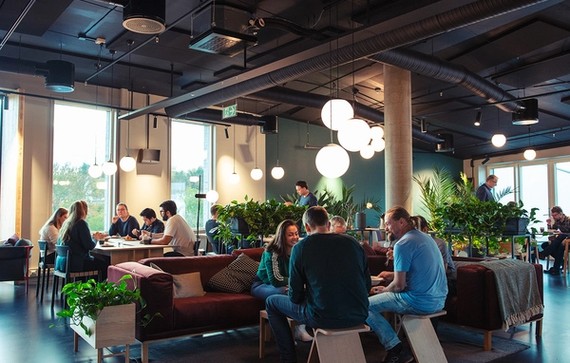Disappearing biodiversity
Ecological disasters are rife around the world. Whether it’s disappearing biodiversity in Brazil or worsening panda habitats in China, almost everywhere we look nature is under threat. To help fight this we need to figure out what’s actually causing each disaster. That sounds simple, but the answers are often more mysterious than one might expect.
In the case of biodiversity decreasing unusually fast in Brazil, Professor Jianguo ‘Jack’ Liu, a sustainability scientist at Michigan State University, says the real cause was far from being obvious.
“It was partly due to natural disasters far away in countries such as the US,” Jack states.
Wait... how on earth can that be? Jack laughs and says that’s the interesting part! One of the causes was the humble little soy plant — and the human-created economy.
We discovered that the panda's habitat was being lost faster, after the establishment of nature reserves in China— Jack Someone
Following invisible threads
The two giants of the Americas are more than 7,000 km away from each other, so there’s not much connecting them ecologically speaking. But they happen to be the world’s two largest soybean producers, each growing more than 100 million tonnes of beans every year. Competition is fierce and this means deep interconnectivity between markets.
“If a drought in the US affects the soybean crop, then global soybean prices can skyrocket,” explains Jack. When this happens, the market environment encourages Brazilian farmers to take advantage of the situation and up their production while prices are high. But this means expanding the land needed to farm these plants.
The rainforest is one choice, but as Jack explains, “a number of international supply chain agreements are in place to reduce deforestation in the Amazon.” So farmers in Brazil are supposed to look towards other types of land which should disrupt biodiversity and ecosystems less. Unfortunately, however, the next options are also global biodiversity hotspots. “Forests and grasslands may seem innocuous,” says Jack, “but they hide a wealth of biodiversity too.”
Ecological disasters are increasingly common worldwide, impacting biodiversity in Brazil and panda habitats in China, among other things. These threats to nature often have complex and surprising causes, with factors ranging from remote natural disasters to economic changes related to agricultural production.
Despite the physical distance between Brazil and the US, these two largest soybean producers are closely linked through global market dynamics. A drought in the US could cause a spike in soybean prices, encouraging Brazilian farmers to increase production, which often entails expanding farming land. This expansion can disrupt ecosystems and affect biodiversity hotspots.
The concept of 'telecoupling' coined by Professor Jianguo 'Jack' Liu, refers to the social, economic, and environmental interactions between humans and nature across geographical distances. This concept helps to unravel the intricate connections and impacts that can lead to ecological crises.
This ecological and economic connection across continents is just one example of ‘telecoupling’. The term, first coined by Jack, combines disciplines to describe social, economic, and environmental interactions between humans and nature over geographical distances and helps solve ecological mysteries. “It’s important to also consider human needs in sustainability research,” says Jack, “because without this there is no way that we can make the policy work.”
But why would traditional ecology research not find the link between the US and Brazil?

Weaving together disciplines
“When I first proposed incorporating humans into this kind of research, several decades ago, many ecologists laughed,” says Jack. “There had been a lot of studies on distant interactions in the past, but the focus was on the human side or the natural side – not the interactions between the two.” Sceptical colleagues have now changed their views and some even follow similar lines of interdisciplinary research.
As part of his role as a sustainability scientist, Jack is the Rachel Carson Chair in Sustainability and Director for the Center of Systems Integration and Sustainability, where inter- and transdisciplinarity are at the core. “We take a holistic approach,” explains Jack, “integrating natural sciences, social sciences, technology, and policy to understand and promote global sustainability.
Jack’s work, including the concept of telecoupling, ensured his success as the 2021 winner of Norway’s Gunnerus Award in sustainability. The internationally coveted prize was established by Norway’s oldest scientific institution DKNVS (Det Kongelige Norske Videnskabers Selskab) and is named after the institution’s founder Johan Ernst Gunnerus. Since 2017, DKNVS and NTNU have awarded the prize together every two years.

For Jack, the recognition of his work by the Gunnerus Award represents a fundamental shift in the ecology community. “It’s marvellous to see these kinds of changes and I’m very honoured to receive this award,” he says.
In the context of daily life, the concept of telecoupling can extend far beyond the world of science and into the realm of decision-making. It's about understanding how an action taken in one part of the world can ripple and create a significant effect somewhere else. This understanding helps shape our choices and can guide us towards more sustainable decisions. The food we buy, the clothes we wear, the energy we use - each of these actions, and their impact, may seem small in isolation. However, when viewed through the lens of telecoupling, they are part of a global network of interconnected actions and reactions.
The role of consumers can be decisive in addressing global environmental challenges. Consumers, empowered with knowledge and understanding, can drive change. They can preferentially choose products that are sustainably sourced, reduce their overall consumption, recycle and upcycle items, and make dietary shifts to lessen their environmental footprint. Every action, every purchase decision made with an understanding of its far-reaching impacts, has the potential to contribute towards a more sustainable planet. Jack notes, “it's about making informed choices. A consumer who understands the concept of telecoupling can contribute significantly towards biodiversity conservation by adjusting their purchasing behaviors.” Knowledge truly is power - and in this case, the power to drive change towards a more sustainable future.
Policy changes and personal action
Jack will visit Trondheim in September to accept the award and give a seminar about his work. In his talk, entitled ‘Pandas, People, and Planetary Sustainability’, you can find out more about telecoupling and how it led to the removal of pandas from the list of endangered species, through its incorporation into policy.
“We discovered that the panda’s habitat was being lost faster, after the establishment of nature reserves in China,” explains Jack. “Even the president of China at that time knew about our paper!” After some initial negativity, government officials were keen for Jack and his team to find solutions that could be implemented with policy. By using ecology, economics, and social sciences in the context of the telecoupling framework, that’s exactly what they did.
Research and policy change is beginning to help save pandas and their biodiverse habitat. But personal, collective action can help against other environmental problems. “Often, we don’t see the impact of our actions, far away,” says Jack. “But if we add our impact together, it’s huge.”
When it comes to saving Brazilian biodiversity, that doesn’t mean giving up tofu, tempeh, and soy-based milk alternatives. Quite the opposite in fact, as soybeans feed a different industry altogether; more than three-quarters of annual production is fed to livestock for meat, milk, and eggs.
“By applying the telecoupling framework to our day-to-day activities, we can consider what impact our actions have on places far away from us,” says Jack, “and this will help us to address global challenges.”